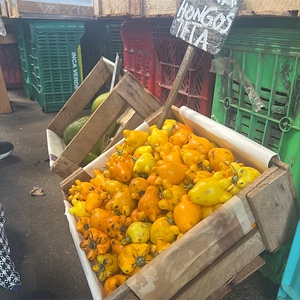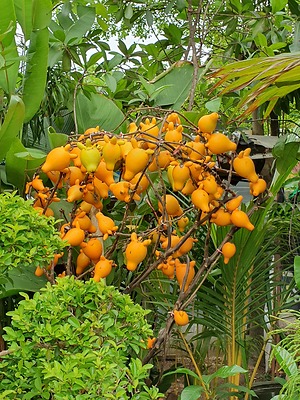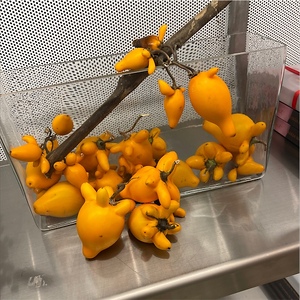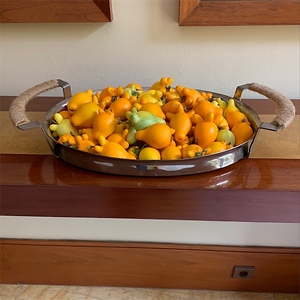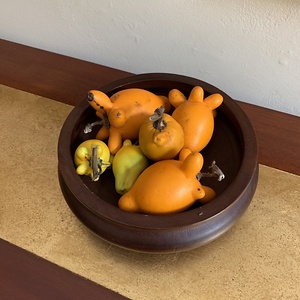

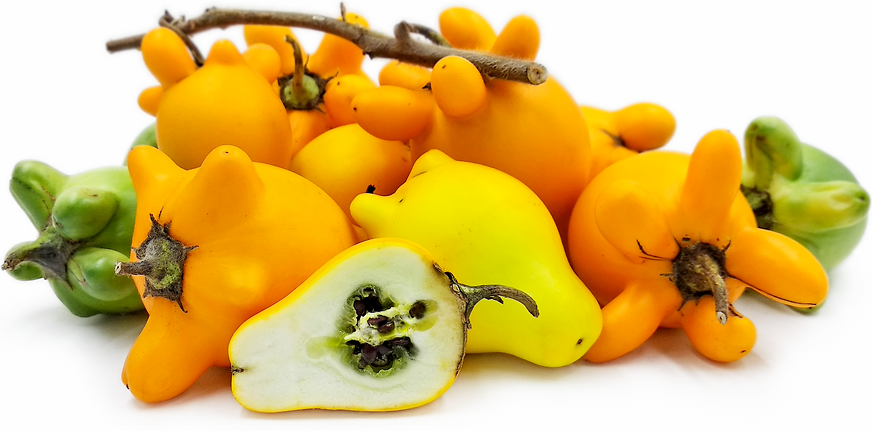
Nipplefruit
Estimated Inventory, lb : 0
Description/Taste
Nipplefruit is small to medium in size, averaging 4 to 10 centimeters in diameter and 7 to 12 centimeters in length, and has a bulbous, oval shape with 1 to 5 protrusions surrounding the stem end. Each protrusion sometimes referred to as a satellite fruit or finger, is small with a blunt curved end, and most Nipplefruits have five protrusions, resembling a cow’s udder. The main central portion of the fruit has a pyriform, swollen appearance, tapering slightly toward the non-stem end. Nipplefruits have smooth, firm, and taut skin, ripening from green to shades of yellow and orange with maturity. The fruits also have a waxy feel and are harvested when they have become a saturated orange. Underneath the surface, a spongy or cottony layer of white flesh encases a cavity filled with tiny, red-brown to black-brown seeds. The seeds are suspended in a green, gelatinous, and slippery pulp. Nipplefruits are not edible and are considered poisonous when raw, especially mature fruits. Some communities in South America cook and consume young fruits, but this is not recommended. The fruits are sold in fresh markets as an ornamental.
Seasons/Availability
Nipplefruit generally appears in the late summer through fall.
Current Facts
Nipplefruit, botanically classified as Solanum mammosum, is an unusual ornamental species belonging to the Solanaceae or nightshade family. The oddly shaped fruits grow directly along the branches of a shrub or small tree reaching 0.6 to 1.8 meters in height and are nestled between large, velvety, purple-veined leaves. The branches and stems are also covered in sharp spines, making it somewhat challenging to harvest the fruits, and the fruits are foraged from wild and cultivated plants for decorative uses. Nipplefruit is a vigorous, fast-growing, and aggressive species considered a weed in several regions worldwide. The species is also commercially grown for floral arrangements in Asia. The species acquired its curious name from its resemblance in shape to a woman’s breast and a cow’s udder. The colorful fruits are also known by other regional names, including Cow’s Udder, Apple of Sodom, Titty Fruit, and Love Apples in English, and Kitsunenanasu meaning Fox Eggplant, Tsunonasu meaning Horned eggplant, Kanariyanasu or Canary eggplant, and Fokkusu Feisu meaning Fox Face in Japanese. In China, Nipplefruit is called Five-Fingered eggplant and Wu Dai Tong Tang, and in Central and South America, the fruits are referred to as Berenjena de Cucarachas, Marimba, Tetilla, and Gurito. Nipplefruits are grown worldwide and are cultivated for ornamental purposes.
Nutritional Value
Nipplefruit is not consumed for its nutritional properties. It is said the fruits are a source of calcium, iron, B vitamins, and phosphorus, but little scientific research supports these claims. The fruits are also not traditionally eaten, especially when mature. In some natural medicines and folkloric uses throughout South America and Asia, Nipplefruit is applied topically to skin irritations, burns, sores, and rashes. In China, the fruits are thought to externally reduce swelling and remove heat from the body. In Belize, the fruits and leaves are used topically for athlete’s foot. The fruits are also used as an insect repellent and natural detergent for washing fabric.
Applications
Mature Nipplefruit is poisonous and should not be consumed. Worldwide, the plant is generally ruled inedible and is not utilized in culinary preparations. In some communities throughout its native growing region in South America, it is said that unripe Nipplefruit may be edible after it is cooked like a vegetable. It is important to note that it is not recommended for consumption, and there is no research or evidence to claim that unripe fruits are truly edible. While some communities may choose to eat the fruits, discussion with a medical professional before consumption is mandatory. It is better to consider Nipplefruits inedible and primarily ornamental. In the Philippines, young Nipplefruit is occasionally boiled whole, and the liquid is consumed. The leaves are also prepared as tea and are considered a mild narcotic. Nipplefruit will keep up to two weeks when stored whole and unwashed in a cool and dry place.
Ethnic/Cultural Info
Nipplefruit is an auspicious symbol of wealth and longevity during Lunar New Year celebrations. The fruits are used in decorative holiday arrangements and are often tied to bamboo sticks in a pyramid-like shape, taking the form of a small tree. Traditionally, three bamboo stalks are used as the base to denote longevity, wealth, and happiness. In China, Nipplefruit is favored for its yellow-orange coloring, said to resemble gold, representing wealth and prosperity. The fruits are commercially produced throughout China for sale during the New Year celebrations, and the fruits with five fingers or protrusions are the most popular. Nipplefruits are called Wu Dai Tong Tang in China, meaning "Five Generations Living Harmoniously Under One Roof." Each finger on the fruit symbolizes a generation, and the fruit, as a whole, represents harmony between the generations. Nipplefruits are typically sold in flower and fresh markets throughout China about one week before the holiday. In Japan, Nipplefruits are used in floral arrangements beginning in September as a festive fall element. The fruits are prized for their unusual shape, adding dimension and color to floral displays.
Geography/History
Nipplefruit is native to South America and has been growing wild since ancient times. Much of the fruit’s history is unrecorded as it was never a plant with widespread culinary or medicinal value, but over time, Nipplefruit was spread into Central America and the Caribbean through migrating peoples, trade, and animals. The species also has aggressive growth tendencies and is often labeled as a weed in some regions. Nipplefruit was carried to Asia in the 1930s and naturalized in areas throughout Southeast Asia and East Asia. Nipplefruit thrives in moist soils and easily adapts to various climates. The fruits were planted for commercial cultivation in China in Yunnan, Guangxi, and Guangdong Provinces, and in Japan, the species was grown in the late 1950s and 1960s as a decorative element in floral arrangements. Nipplefruits were first planted in Japan's Chiba Prefecture and later cultivated in Ibaraki and Okayama Prefectures. Today, Nipplefruits are grown worldwide and are an ornamental species. When in season, Nipplefruits are sold through fresh and floral markets in Asia, the Caribbean, Mexico, Central America, and South America.



